|
2.3 Fuzzy Relations
2.3.1 Introduction
Fuzzy relations play an important role in fuzzy modeling, fuzzy diagnosis, and fuzzy control. They also have applications in fields such as psychology, medicine, economics, and sociology. In this notebook we define and discuss fuzzy relations. Beginning with a definition of fuzzy relations, we then talk about expressing fuzzy relations in terms of matrices and graphical visualizations. Later we discuss the various properties of fuzzy relations and operations that can be performed with fuzzy relations.
We illustrate the basic properties of fuzzy relations using the graphical functions of Fuzzy Logic, along with standard Mathematica functions.
This loads the package.
In[1]:=
2.3.2 Fuzzy Relation Form
A fuzzy relation is characterized by the same two items as a fuzzy set. First is a list containing element and membership grade pairs, {{ , ,  }, },  }, {{ }, {{ , ,  }, },  }, ... , {{ }, ... , {{ , ,  }, },  }}. Note that the elements of the relation are defined as ordered pairs, { }}. Note that the elements of the relation are defined as ordered pairs, { , ,  }, { }, { , ,  }, ... , { }, ... , { , ,  }. These elements are again grouped with their membership grades, { }. These elements are again grouped with their membership grades, { , ,  , ... , , ... ,  }, which are values that range from 0 to 1, inclusive. }, which are values that range from 0 to 1, inclusive.
The second item characterizing fuzzy relations is the universal space. For relations, the universal space consists of a pair of ordered pairs, {{ , ,  , ,  }, { }, { , ,  , ,  }}. The first pair defines the universal space to be used for the first set under consideration in the relation, and the second pair defines the universal space for the second set. The following is an example showing how fuzzy relations are represented in this package. }}. The first pair defines the universal space to be used for the first set under consideration in the relation, and the second pair defines the universal space for the second set. The following is an example showing how fuzzy relations are represented in this package.
Universal spaces for fuzzy sets and fuzzy relations are defined with three numbers in this package. The first two numbers specify the start and end of the universal space, and the third argument specifies the increment between discrete elements. Here is an example.
FuzzyRelation[{{{1, 1}, 0.1}, {{1, 2}, 0.5}, {{2, 1}, 0.9}, {{2, 2}, 0.7}, {{3, 1}, 0.4}, {{3, 2}, 1}}, UniversalSpace {{0, 3, 1}, {0, 2, 1}}] {{0, 3, 1}, {0, 2, 1}}]
Assuming that V and W are two collections of objects, an arbitrary fuzzy set R, defined in the Cartesian product VxW, will be called a fuzzy relation in the space VxW.
R is thus a function defined in the space VxW, which takes values from the interval [0, 1].
R : V x W  [0, 1] [0, 1]
In the case where V = W, we have a binary fuzzy relation on a single set V.
We can start our discussion by considering a countable collection of objects.
V = { }, i = 1, 2, ... }, i = 1, 2, ...
W = { }, j = 1, 2, ... }, j = 1, 2, ...
A fuzzy relation R can be represented in the following way:
R = {{{ , ,  }, R( }, R( , ,  )}}, i = 1, 2, ... ; j = 1, 2, ... )}}, i = 1, 2, ... ; j = 1, 2, ...
A matrix or graphic interpretation is a more convenient way to study fuzzy relations. We examine fuzzy relations in this notebook in a manner analogous to that introduced earlier for fuzzy sets.
Let V = {1, 2, 3} and W = {1, 2, 3, 4}.
A fuzzy relation R in VxW has the following definition.
In[2]:=
This relation can be represented in the following two forms:
as a membership matrix
In[3]:=
Out[3]//MatrixForm=
as a graph
In[4]:=
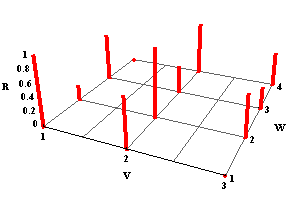
Note that the elements of the fuzzy relation are defined as ordered pairs;  is the first and is the first and  the second element of an ordered pair { the second element of an ordered pair { , ,  }. The membership grades of the elements are represented by the heights of the vertical lines at the corresponding elements. }. The membership grades of the elements are represented by the heights of the vertical lines at the corresponding elements.
2.3.3 Projection of a Fuzzy Relation
Let R be a fuzzy relation in the Cartesian product VxW. The fuzzy set R(1) defined in V by the following expression is called the first projection of fuzzy relation R.
For all v in the set V, R(1)(v) = Max(R(v, w)), for all w in the set W
The fuzzy set R(2) defined in W in the following expression is called the second projection of fuzzy relation R.
For all w in the set W, R(1)(w) = Max(R(v, w)), for all v in the set V
The number defined by the following expression is called the global projection of fuzzy relation R.
h(R) = Max(Max(R(v, w))), for all v in the set V and all w in the set W
The fuzzy relation R: h(R) = 1 is called normal. If h(R) < 1, the relation is called subnormal.
For the fuzzy relation we defined earlier, the projections are shown here.
In[5]:=
In[6]:=
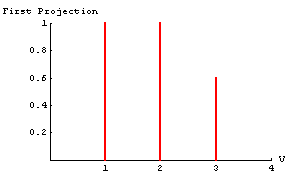
In[7]:=
In[8]:=
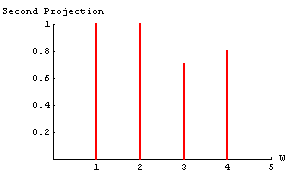
In[9]:=
Out[9]=
We see that this relation is normal since its global projection is 1.
2.3.4 Fuzzy Operations
Here we present the basic properties of fuzzy relations and the basic operations that can be performed on fuzzy relations. We begin with operations defined for fuzzy relations in the same universal space-the same Cartesian product of two collections of objects.
Envelope of a Fuzzy Relation
If R and S are two fuzzy relations of VxW such that for all v and w in VxW, R(v, w)  S(v, w), we say that fuzzy relation S is an envelope of fuzzy relation R or that fuzzy relation R is an enclosure of fuzzy relation S. S(v, w), we say that fuzzy relation S is an envelope of fuzzy relation R or that fuzzy relation R is an enclosure of fuzzy relation S.
In the example that follows, fuzzy relations R and S are defined in VxW where sets V and W were defined earlier. Relations R and S satisfy the envelope condition stated here, so we can say that fuzzy relation R is an enclosure of S.
In[10]:=
In[11]:=
In[12]:=
In[13]:=
In[14]:=
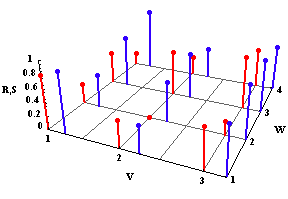
Union of Fuzzy Relations
Let R and S be fuzzy relations in VxW. The union of two fuzzy relations R and S, denoted by R  S, is a fuzzy relation in V x W, such that for all (v, w) in V x W. Then S, is a fuzzy relation in V x W, such that for all (v, w) in V x W. Then
(R  S)(v, w) = Max(R(v, w), S(v, w)). S)(v, w) = Max(R(v, w), S(v, w)).
We demonstrate this operator in the following example.
In[15]:=
In[16]:=
In[17]:=
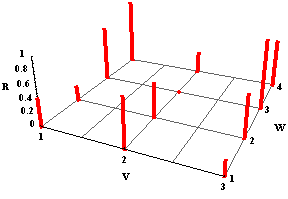
In[18]:=
In[19]:=
In[20]:=
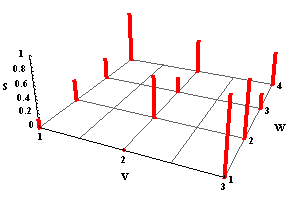
The union of fuzzy relations R and S is the following relation.
In[21]:=
In[22]:=
Out[22]//MatrixForm=
In[23]:=
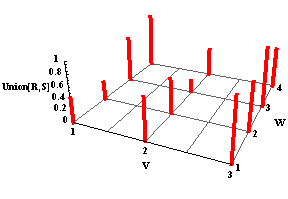
The operation of the union of fuzzy relations can be generalized to n relations. If  , ,  , ... , , ... ,  are fuzzy relations in VxW then their union is a relation defined in VxW such that for all (v, w) in VxW, R(v, w) = Max( are fuzzy relations in VxW then their union is a relation defined in VxW such that for all (v, w) in VxW, R(v, w) = Max( (v, w)). (v, w)).
Intersection of Fuzzy Relations
The intersection of two fuzzy relations, R and S, in VxW is the fuzzy relation in VxW such that for all (v, w) in VxW, (R  S)(v, w) = Min(R(v, w), S(v, w)). S)(v, w) = Min(R(v, w), S(v, w)).
The intersection of the fuzzy relations from the previous example is shown here.
In[24]:=
In[25]:=
Out[25]//MatrixForm=
In[26]:=
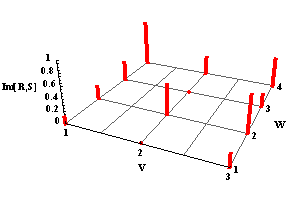
The intersection of the fuzzy relation can also be generalized to the intersection of n relations in the same way it was generalized for the union operation.
Algebraic Product of Fuzzy Relations
The algebraic product of the two fuzzy relations R and S in the space VxW is defined as a fuzzy set in VxW, whose elements satisfy the relation, for all (v, w) in VxW, AlgProduct(R, S)(v, w) = R(v, w) * S(v, w).
For the relations R and S presented earlier, the algebraic product is the following fuzzy relation.
In[27]:=
In[28]:=
Out[28]//MatrixForm=
Complement of a Fuzzy Relation
The complement of the fuzzy relation R is denoted by R'; the relation R' is defined in the same space as R. It is defined as, for all (v, w) in VxW, R'(v, w) = 1 - R(v, w).
The complement of fuzzy relation R is shown in the following graph.
In[29]:=
In[30]:=
Out[30]//MatrixForm=
In[31]:=
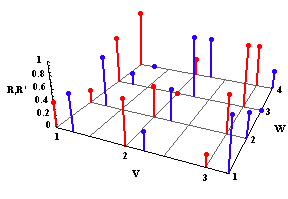
2.3.5 Composition of Two Fuzzy Relations
So far we have considered operations on fuzzy relations defined in the same space as the Cartesian product of two collections of objects. Now we shall consider the composition of two fuzzy relations.
Let  be a fuzzy relation in UxV and be a fuzzy relation in UxV and  a fuzzy relation in VxW. We shall present two ways of composing such relations. a fuzzy relation in VxW. We shall present two ways of composing such relations.
Max-Min Composition
The max-min composition of relations  and and  denoted by MaxMin( denoted by MaxMin( , ,  ) is a fuzzy relation in UxW, such that for all (u, w) in UxW, MaxMin( ) is a fuzzy relation in UxW, such that for all (u, w) in UxW, MaxMin( , ,  )(u, w) = Max(Min( )(u, w) = Max(Min( (u, v), (u, v),  (v, w))) over all v in the set V. (v, w))) over all v in the set V.
Consider for example U = {1, 2, 3, 4, 5}, V = {1, 2, 3}, W = {1, 2, 3, 4}, and the following fuzzy relations.
In[32]:=
In[33]:=
In[34]:=
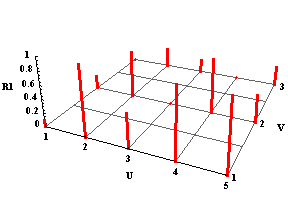
In[35]:=
In[36]:=
In[37]:=
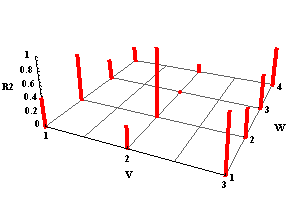
We can now find the composition of fuzzy relations R1 and R2.
In[38]:=
In[39]:=
Out[39]//MatrixForm=
In[40]:=
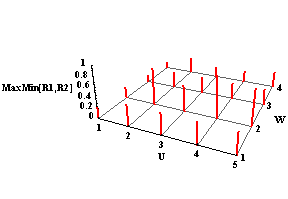
Note that the new fuzzy relation, MAXMIN, is defined on the space UxW.
Max-Star Composition
We continue by considering the two fuzzy relations  in UxV and in UxV and  in VxW. in VxW.
The max-star composition of such relations is the composition created by replacing the min operation in the previous composition definition by any other operation that is associative and monotonic non-decreasing in each argument. In the definition of composition, this operation is denoted by a star, hence the name of the composition. The max-star composition is defined such that for all (u, w) in UxW, MaxStar( , ,  )(u, w) = Max( )(u, w) = Max( (u, v)* (u, v)* (v, w)) over all v in the set V. (v, w)) over all v in the set V.
If we take the algebraic product for the star operation, then we will obtain a composition referred to as the max-product, which is defined in the following way:
For all (u, w) in UxW,
MaxProduct( , ,  )(u, w) = Max( )(u, w) = Max( (u, v) (u, v)   (v, w)) over all v in the set V. (v, w)) over all v in the set V.
For relation R1 and R2 from previous example, we obtain the fuzzy relation.
In[41]:=
In[42]:=
Out[42]//MatrixForm=
In[43]:=
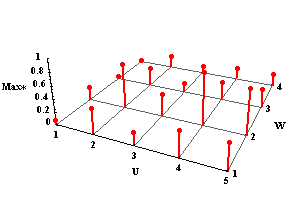
Again the new fuzzy relation is defined on the space UxW.
2.3.6 Binary Relations
We now consider binary fuzzy relations in U, that is, fuzzy relations defined in the Cartesian product UxU.
Symmetry
We say that a binary fuzzy relation R in U is symmetric if for all (u, v) in UxU, (R(u, v) = a)  (R(v, u) = a). An example of a symmetric, binary fuzzy relation in U = { (R(v, u) = a). An example of a symmetric, binary fuzzy relation in U = { , ,  , ,  , ,  } is shown here. } is shown here.
In[44]:=
In[45]:=
In[46]:=
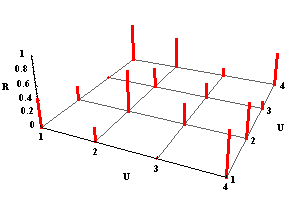
Note that the membership grades are symmetric about the main diagonal.
Reflexivity
A binary fuzzy relation R in U is reflexive if for all u in the set U, R(u, u) =1. The following relation is a reflexive relation.
In[47]:=
In[48]:=
In[49]:=
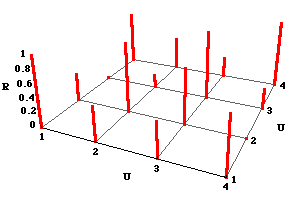
Note that the membership grades of the main diagonal all have a height of 1.
Transitivity
If a binary fuzzy relation R in U satisfies the condition that for all (u, v) in UxU, R(u, v)  Max(Min(R(u, w), R(w, v))) for all w in the set U, then we say that the relation is transitive. A transitive relation is shown in the following example. Max(Min(R(u, w), R(w, v))) for all w in the set U, then we say that the relation is transitive. A transitive relation is shown in the following example.
In[50]:=
In[51]:=
In[52]:=
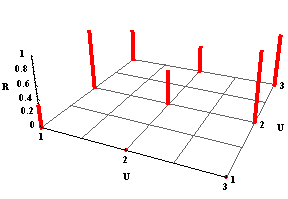
Before we check that this is really a transitive relation, note that the condition for transitivity can be written as follows:
For all (u, v) in UxU, R(u, v)  Composition(R, R)(u, v) Composition(R, R)(u, v)
From this condition, we can formulate that a binary fuzzy relation R in U is transitive if the following condition is true:
Composition(R, R) must be a subset of R
For the binary fuzzy relation we used earlier, the composition is the following fuzzy relation.
In[53]:=
In[54]:=
Out[54]//MatrixForm=
In[55]:=
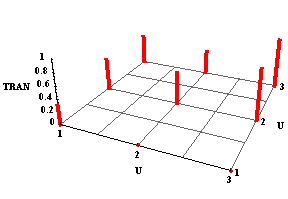
From the following graph, where we show both the composition and the original fuzzy relation, we see that the composition is indeed a subset of the original fuzzy relation, R. This proves that this binary fuzzy relation is indeed transitive.
In[56]:=
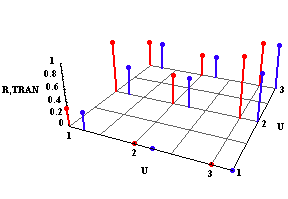
Antisymmetry
A fuzzy binary relation R in U is antisymmetric if for all (u, v) in UxU, R(u, v) does not equal R(v, u) or if R(u, v) = R(v, u) = 0. An example of an antisymmetric relation is shown here. It is a fuzzy relation in U = { , ,  , ,  , ,  }. }.
In[57]:=
In[58]:=
In[59]:=
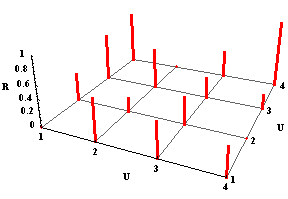
References
G. J. Klir and T. A. Folger, Fuzzy Sets, Uncertainty, and Information, Prentice Hall, Englewood Cliffs, NJ, 1988.
M. S. Stachowicz and M. E. Kochanska, Graphic interpretation of fuzzy sets and fuzzy relations, Mathematics at the Service of Man. Edited by A. Ballester, D. Cardus, and E. Trillas, based on materials of Second World Conf., Universidad Politecnica Las Palmas, Spain, 1982.
L. A. Zadeh, Fuzzy sets, Information and Control, vol. 8, pp. 338-353, 1965.
H. J. Zimmermann, Fuzzy Set Theory and Its Applications, 2nd ed., Kluwer Academic Publishers, Boston, MA, 1991.
|